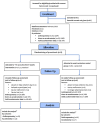Pre-school-based behaviour change intervention to increase physical activity levels amongst young children: a feasibility cluster randomised controlled trial
- PMID: 38756888
- PMCID: PMC11096494
- DOI: 10.3389/fpubh.2024.1379582
Pre-school-based behaviour change intervention to increase physical activity levels amongst young children: a feasibility cluster randomised controlled trial
Abstract
Background: A significant rise in childhood obesity worldwide over the past three decades highlights the urgent need for early interventions, especially in preschools as key settings for child development. This study aimed to assess the feasibility and fidelity of a randomised controlled trial of "I'm an Active Hero" (IAAH), a theory- and evidence-based multi-component behaviour change intervention targeting physical activity and sedentary behaviour amongst preschool-aged children.
Methods: Two preschools in Taif city, Saudi Arabia were randomly assigned to either the intervention (n = 3 classrooms) or the usual curriculum control group (n = 3 classrooms). The intervention ran for 10 weeks from February to April 2023 and consisted of teacher-led physical activity and sedentary behaviour sessions in preschools, with an additional interactive home component. Primary outcome measures included intervention fidelity, recruitment rates, attrition rates, and compliance with trial procedures. Secondary outcomes included body mass index (BMI), objectively measured physical activity, and sedentary time via the ActiGraph GT3X accelerometer. Outcomes were measured at baseline and at 10 weeks in both study arms.
Results: The preschool intervention component had high fidelity (93.3%), but the home component fidelity was lower (74%). A cluster-level recruitment rate of 12% (13/112 centres) was attained, whilst the individual-level recruitment rate stood at 36% (52/143 children, mean age of 4.16 years; 23 girls). Attrition was 10%. Compliance varied with 90% for BMI, 71% for accelerometery, and 45% for questionnaires. The intervention group showed small decreases in BMI, slight increases in physical activity, and decreases in sedentary time at follow-up compared to the control group. Parents, facilitators, and assistant teachers considered the intervention to be feasible and beneficial.
Conclusion: The IAAH intervention was feasible to implement in Saudi Arabian preschools. Facilitators showed high fidelity in delivering it. However, preliminary data did not demonstrate effectiveness. A more comprehensive evaluation across a broader population is warranted. The intervention could be revised to optimise recruitment, compliance, and fidelity of the home-based component. Successful elements from this pilot should be retained whilst adaptations to implementation are made to strengthen key areas.Clinical trial registration: ClinicalTrials.gov, NCT05754359.
Keywords: Saudi Arabia; childhood obesity; feasibility; physical activity intervention; prevention; sedentary behaviour; young children.
Copyright © 2024 Al-walah, Donnelly, Alhusaini and Heron.
Conflict of interest statement
The authors declare that the research was conducted in the absence of any commercial or financial relationships that could be construed as a potential conflict of interest.
Figures
Similar articles
-
A feasibility cluster randomised controlled trial of a preschool obesity prevention intervention: ToyBox-Scotland.Pilot Feasibility Stud. 2019 Nov 9;5:128. doi: 10.1186/s40814-019-0521-7. eCollection 2019. Pilot Feasibility Stud. 2019. PMID: 31728203 Free PMC article.
-
Adapting the ToyBox obesity prevention intervention for use in Scottish preschools: protocol for a feasibility cluster randomised controlled trial.BMJ Open. 2018 Oct 27;8(10):e023707. doi: 10.1136/bmjopen-2018-023707. BMJ Open. 2018. PMID: 30368450 Free PMC article.
-
The CHIRPY DRAGON intervention in preventing obesity in Chinese primary-school--aged children: A cluster-randomised controlled trial.PLoS Med. 2019 Nov 26;16(11):e1002971. doi: 10.1371/journal.pmed.1002971. eCollection 2019 Nov. PLoS Med. 2019. PMID: 31770371 Free PMC article. Clinical Trial.
-
Strategies to improve the implementation of healthy eating, physical activity and obesity prevention policies, practices or programmes within childcare services.Cochrane Database Syst Rev. 2020 Feb 10;2(2):CD011779. doi: 10.1002/14651858.CD011779.pub3. Cochrane Database Syst Rev. 2020. PMID: 32036618 Free PMC article.
-
Effectiveness of interventions aiming at reducing sedentary behaviour in a non-surgical population with overweight or obesity: A systematic review and meta-analysis.Obes Res Clin Pract. 2019 Mar-Apr;13(2):115-128. doi: 10.1016/j.orcp.2018.10.004. Epub 2018 Nov 13. Obes Res Clin Pract. 2019. PMID: 30446257
Cited by
-
Assessing the Acceptability of a Preschool-Based Multi-Component Physical Activity Intervention Entitled "I'm an Active Hero" (IAAH): Process Evaluation of a Feasibility Trial.Healthcare (Basel). 2024 Jul 12;12(14):1398. doi: 10.3390/healthcare12141398. Healthcare (Basel). 2024. PMID: 39057541 Free PMC article.
References
Publication types
MeSH terms
Associated data
LinkOut - more resources
Full Text Sources
Medical
Miscellaneous


